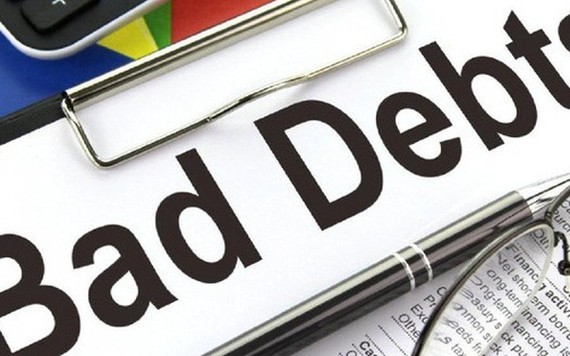
There are now various opinions on how to deal with bad debts although banks have already created a buffer against further bad debts to avoid increasing risks.
Bad debt risks
The second quarter financial statements of commercial banks state that the total amount of bad debts on the balance sheet at VPBank stood at VND20,625 bln, up 27 percent compared to the beginning of the year, bringing the bad debt and loan ratio on the bank consolidated report to increase sharply from 4.57 percent to 5.25 percent . VietBank was also in the group with a bad debt ratio exceeding the prescribed threshold at 3.99 percent. Although the remaining banks still kept the bad debt ratio at 3 percent, it was clear that bad debts are now showing signs of further increasing.
At Vietnam International Commercial Joint Stock Bank (VIB), the total bad debt at the end of June stood at around VND5,428 bln, a 16.2 percent increase compared to the beginning of the year. In this, Group 4 debt increased 32 percent to VND2,125 bln, and Group 5 debt increased 67 percent to VND2,210 bln. In the first six months of the year, Group 4 debt at TPBank increased by 23.4 percent to VND430.5 bln and Group 5 debt increased by more than 50 percent to VND448.6 bln. Total bad debt of TPBank increased by 11.1 percent to VND1,285.3 bln and bad debt ratio increased from 0.81 percent to 0.85 percent Group 5 debt at LienVietPostBank increased by 37.8 percent to VND1,837.7 bln and Group 3 debt increased by 67.5 percent to VND771 bln. In SaigonBank, Group 3 debt increased by 149 percent to VND42.5 bl, and Group 4 debt increased by 558 percent to VND121.7 bln.
This increase in bad debt was not unexpected. According to Dr. Can Van Luc, a member of the National Monetary Policy Advisory Council, at the end of 2016, on-balance sheet bad debt was 2.5 percent and gross bad debt was 10.1 percent, including on-balance sheet bad debt reported by credit institutions and unresolved debt sold to Vietnam Asset Management Company (VAMC) and contingent liabilities. In September 2017, bad debt on the balance sheet was at 2.34 percent and gross bad debt was at 8.61 percent. By 2021, on-balance sheet bad debt was 1.5 percent and gross bad debt was about 6.3 percen.
The data shows that bad debt has decreased quite sharply. At the end of the first quarter of 2022, the bad debt of 29 commercial banks decreased by 12.8 percent, the bad debt in the table was 1.4 percent, and the gross bad debt decreased by 6 percent. The gross bad debt decreased mainly due to the recovery of the economy and the use of risk provisions by credit institutions. It is forecast that by the end of the year, the bad debt on the balance sheet of credit institutions may be pushed up to 2 percent.
The financial statements of the last quarter show there were still some banks that announced a decrease in bad debts compared to the beginning of the year. However, the total bad debt on the balance sheet of 27 banks was nearly VND146,200 bn, an increase of 17.5 percent compared to the beginning of the year. But the end of the second quarter is also the time when Circular 14/2021 just expired.
According to SSI Research, the rate of bad debt formation is forecast to increase in the second half of the year due to the expiration of restructuring loans. At the same time, credit risks related to the real estate sector and the corporate bond market should continue to be closely monitored. In such context, bad debt will have many surprises in the last six months of the year.
Provisions for risks
Currently, a number of commercial banks are responding to bad debts by increasing provisions for risks by pushing the bad debt coverage ratio to a higher level. The group of commercial banks with a profit of over VND10,000 bln have a bad debt coverage ratio of 150 percent to 500 percent, i.e., one VND of bad debt of a bank has upto VND1.5 to VND5 for provision. The next most profitable group also has a bad debt coverage ratio of around 100 percent.
Because of this, recently there have been quite a lot of comments that bad debts caused by the Covid-19 pandemic will gradually reappear, but the proactive provision of Diversified Payment Rights (DPR) by banks will make the worries gradually decrease. However, the thick buffer is only available in large-scale commercial banks, while other remaining groups still has a bad debt coverage ratio of 50 percent such as VietBank, PGBank, ABBank, Saigonbank, and even BaoVietBank which has 28 percent bad debt coverage ratio.
Speaking to Saigon Investment, Mr. Nguyen Tri Hieu, a banking and financial expert said that the problem is that a high Non-Performing Loan (NPL) coverage ratio is considered a good sign, but only on the books or journal entries. In other words, the announced risk provisions are not necessarily the real cash flow put into the fund so that when handling bad debts, the bank takes this out to compensate for the debt loss.
The high-risk provision will be a way for the bank to ensure to shareholders, investors, banks that are lending them and also the State Bank of Vietnam, that the profit on the books will not be affected by bad debts. But the amount on the books by this accounting method will potentially be lost loan cash flow if the debt is not recovered. This is the cause leading to loss of liquidity in banks, especially small-sized banks.
To compensate for the loss of liquidity, banks will have to mobilize real money to make up for the loss of cash from lending over the last many years. Deposit rates are increasing and will continue to increase. This also explains why many banks no longer have set a limit to lending but still increase deposit interest rates to continue to mobilize capital from the people. Mr. Nguyen Tri Hieu noted that banks have high profits, but behind the profits there are many hidden risks which the management agency needs to closely monitor.
The fact that banks are dealing with bad debts is also co-related with year-end interest rates. Because when banks are forced to make provisions for bad debts, whether in the journal entry or in reality, it also pushes up operating costs. Moreover, banks may not have made many provisions for risks in real estate and corporate bonds at the moment, while risks related to this sector are gradually appearing.
Meanwhile, the credit growth target for the whole year of 2022 is 14 percent and the first six months of the year it increased by 9.35 percent, which is a very hot increase. By the end of July, banks had used up their credit limit and could not lend much, which caused a huge bottleneck in operations. At the same time, banks lend mainly medium- and long-term loans while depositing with customers, so the liquidity risk is still very large.
















)

)





